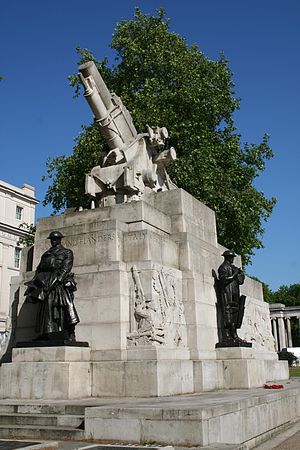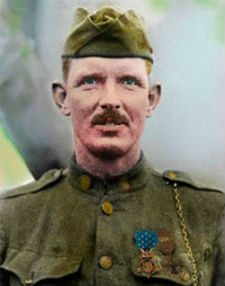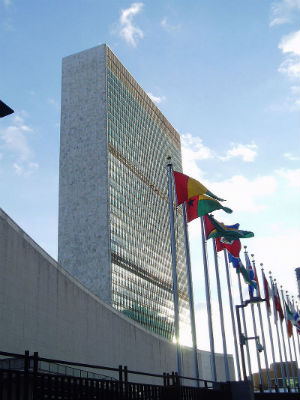‘When the Guns Went Silent:’ Remembering World War One (1914-1918)
By Neil Earle
 The Royal Artillery Memorial in London commemorates the casualties of the Royal Regiment of Artillery in the First World War.
The Royal Artillery Memorial in London commemorates the casualties of the Royal Regiment of Artillery in the First World War.World War Two cemented American dominance in the world but the process was already set in motion by the world-shattering event known as World War One, which ended 101 years ago this November 11.
All across the British Commonwealth you will find more monuments to that awful first war than the one that followed. The casualties were psychologically more shocking due to no one expecting such carnage. The bittersweet legacy endures. That and much more. The Middle Eastern crisis of today traces in some measure to the unreality of the present-day borders in the region. The straight lines often demarcating Syria, Iraq, Iran and Saudi Arabia shows us how much of an unreality some of these nation-building attempts were.
The fact is these lines were drawn as a direct result of the dramatic effects of the horrendous bloodletting that raged from August, 1914 to November, 1918 in Europe and drew in most of the known world (America joined in April, 1917).
A Blizzard of Empires
French and British policy-makers at the Versailles Peace Conference in 1919 were in fact carving up one of the four great empires that collapsed during the fiercest conflict mankind had yet waged. Present day states that often dominate our news such as Iraq, Syria and Iran took root from the fall of the Ottoman Empire (1453-1922). This was a 400 year-long Turkish imperium over most of what we call the Middle East. Iran was outside that orbit which helps explain some of Tehran’s independent thinking to this day.

In 1917 the British took Jerusalem and intruded themselves into the Middle East in the new world order after 1918. They achieved dominance in today’s Iraq, present-day Jordan and the area then known as Palestine. The French dominated Lebanon and Syria. Beirut became known for a while as “the Paris of the Middle East.”
And all because of a quarrel between the Great Powers of Europe over the contentious ethnic and religious rivalries in the Balkans that dragged the nations into war in August 1914.
The Terror Connection
Most historians know that few things are as dangerous as an empire in decline and by August, 1914 this condition applied to three transnational systems – the Ottoman, the Austro-Hungarian in the middle of Europe and the Russian Empire of the Tsars.
Terrorism played its part then too.
When a Serbian nationalist assassinated the Austrian Arch-duke, Austria demanded a part in the ongoing trial. Tsarist Russia backed Serbia in her self-exalted role as “mother of the Slavs.” Germany had an alliance with Austria and Russia was tied to France and France was allied with England. Thus when the Austrian-Russian tension blew up because of conflict in those boundary lands of Eastern Europe – rife with ethnic and religious conflict – the match was lit.
It is not that war was inevitable in August, 1914, it was just that when Germany, feeling encircled, felt it needed to strike first and plough through neutral Belgium, the British felt it had treaty obligations for defending Belgian neutrality.
By August 4 Britain had declared war and the United States – trying to stay out of it – would get inexorably involved when German submarines began sinking American ships selling supplies to Western Europe.
 Sgt. Alvin York from Tennessee single-handedly captured 132 German prisoners during World War Two.
Sgt. Alvin York from Tennessee single-handedly captured 132 German prisoners during World War Two.America Rising
This much most of us learned in high school history class. One of the reasons for so much attention focused on WW1 in Europe this fall is the fact that the affects of this “suicide of Europe” would fall far and wide.
While Europe tore itself apart, most financers and creditors needed a safe place for their investments and the United States soon became the leading creditor nation in the 1920s as exemplified by the building of the Empire State Building in 1929-1931. Financial power had shifted it and with it much of the world power though Britain and France were still big players up till World War Two’s outbreak in 1939.
For Angelinos it was significant that the newly rising film industry was almost suspended in Europe from 1914 to 1918 and thus a small little suburb named Hollywood came out on top. The 1920s of course were the heyday of Charles Chaplin, Douglas Fairbanks and Mary Pickford.
More significantly, if the Spanish-American war of 1898 had announced the United States as a major world power, the shipping of about 2,000,000 U.S “doughboys” overseas served notice that Americans were in the Big Power game to stay in spite of strong tendencies towards isolation between 1918 and 1939. In fact, those fresh, exuberant but inexperienced American troops arrived just “in the nick of time” as Germany began an all-out offensive in March, 1918 that almost reached Paris. The exploits of the former pacifist Alvin York from Tennessee for capturing 132 German prisoners single-handed strengthened the American sense of nationhood on the world stage. President Wilson had stayed out of the war as long as he could in spite of the provocation of American ships being sunk.
 United Nations headquarters in New York. Photo by Steve Cadman
United Nations headquarters in New York. Photo by Steve CadmanThe Dream of Peace
In the end most historians feel Wilson entered the war in April, 1917 in order to have a voice at the Paris Peace Conference of 1919. Wilson’s adopting of a British idea for a League of Nations was defeated back in the United States Senate but the idea of some form of world organization never went away. When the next attempt arose during World War Two, President Franklin Roosevelt made sure America would be in to the neck. The United Nations headquarters would be established in the United States largest city, the UNO building in New York.
The right to national self-determination affecting for the good such countries as Canada and Australia, new national borders, the move to world organization, the shifting of the economic focus across the Atlantic, even the rise of the movie industry and the seasoning of such later successful generals as MacArthur and Patton – all this showed the war was not an unmitigated disaster as some have felt. The effects were indeed potent. This is one reason the brilliant Harvard historian Niall Ferguson has said “World War One changed everything.”
American dominance in the world would be cemented in World War Two but was well under way contained in the events of 1914-1918. That, and the United Nations (warts and all), are two things that have changed our world in many ways for the better.